ART NEWS:April 01
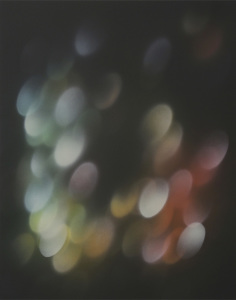 Darren Almond in his solo exhibition “The Swerve / The Light of Time” presents two new series of unpublished paintings. The works can be seen to relate specifically to the passage of time. Darren Almond relies on two concepts that also give the exhibition its title and define our relationship to time and space and play on the foundations of our perception and knowledge. The first one, discovered by Lucretius, the Roman poet of the 1st Century BC, describes a swerve, a spontaneous deviation of the trajectory of the atoms during their fall in the vacuum. This slight deviation of the atoms out of the rectilinear trajectory which is theirs, by virtue of their weight and the gravity, would allow the atoms to collide. The second concept represented in these new paintings “The Light of Time”, is based on a unit of measure; the time-light, it is a measure of perception, explains Darren Almond, of why we have chosen to measure and quantify our existence here with light, and how we have scaled ourselves within a universal time frame. Info: Xippas Gallery, Rue des Sablons 6 & rue des Bains 61, Geneva, Duration 23/3-5/5/18, Days & Hours: Tue-Fri 14:00-18:30, Sat 12:00-17:00, www.xippas.com
Darren Almond in his solo exhibition “The Swerve / The Light of Time” presents two new series of unpublished paintings. The works can be seen to relate specifically to the passage of time. Darren Almond relies on two concepts that also give the exhibition its title and define our relationship to time and space and play on the foundations of our perception and knowledge. The first one, discovered by Lucretius, the Roman poet of the 1st Century BC, describes a swerve, a spontaneous deviation of the trajectory of the atoms during their fall in the vacuum. This slight deviation of the atoms out of the rectilinear trajectory which is theirs, by virtue of their weight and the gravity, would allow the atoms to collide. The second concept represented in these new paintings “The Light of Time”, is based on a unit of measure; the time-light, it is a measure of perception, explains Darren Almond, of why we have chosen to measure and quantify our existence here with light, and how we have scaled ourselves within a universal time frame. Info: Xippas Gallery, Rue des Sablons 6 & rue des Bains 61, Geneva, Duration 23/3-5/5/18, Days & Hours: Tue-Fri 14:00-18:30, Sat 12:00-17:00, www.xippas.com
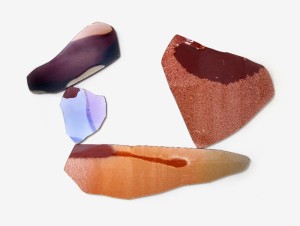 Sara Naim presents her solo exhibition “Reactions”. Naim is known primarily as a photographic artist but in fact makes much of her work using a Transmission Electronic Microscope, Scanning Electron Microscope and a high-resolution Flatbed Scanner. Using these hi-tech tools Naim creates seemingly abstract quasi-photographic imagery which addresses philosophical concerns including the ‘reality’ of physical structures, the notion of the ‘border’ and the possibility that technological glitches reveal new, abstract information. In presenting her work Naim often blurs distinctions between image and object, so that her work becomes a hybrid form between image and sculpture. Her work explores the ways that under examination specific processes and substances can become physical manifestations of abstract reactions. These forms are visualised through the magnification and materialisation of chemical and digital interactions. Massively enlarged biological surfaces and chemical structures thereby become suggestive of landscapes or organisms, and take on pronounced human and emotional resonance. Info: Parafin, 18 Woodstock Street, London, Duration 11/4-19/5/18, Days & Hours: Tue-Fri 10:00-18:00, Sat 12:00-17:00, www.parafin.co.uk
Sara Naim presents her solo exhibition “Reactions”. Naim is known primarily as a photographic artist but in fact makes much of her work using a Transmission Electronic Microscope, Scanning Electron Microscope and a high-resolution Flatbed Scanner. Using these hi-tech tools Naim creates seemingly abstract quasi-photographic imagery which addresses philosophical concerns including the ‘reality’ of physical structures, the notion of the ‘border’ and the possibility that technological glitches reveal new, abstract information. In presenting her work Naim often blurs distinctions between image and object, so that her work becomes a hybrid form between image and sculpture. Her work explores the ways that under examination specific processes and substances can become physical manifestations of abstract reactions. These forms are visualised through the magnification and materialisation of chemical and digital interactions. Massively enlarged biological surfaces and chemical structures thereby become suggestive of landscapes or organisms, and take on pronounced human and emotional resonance. Info: Parafin, 18 Woodstock Street, London, Duration 11/4-19/5/18, Days & Hours: Tue-Fri 10:00-18:00, Sat 12:00-17:00, www.parafin.co.uk
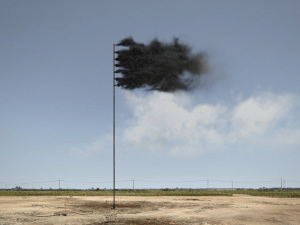 Exploring the theme of climate change the manifesto-exhibition “Eco-Visionaries: Art, Architecture and New Media after the Anthropocene”, this multi-venue exhibition invites thirty-five artists and architects to reflect on the scenarios that await us in a moment of global transformation. The “Eco-Visionaries” project is centreed on current practices that propose critical and creative visions vis-à-vis the environmental transformations that are affecting our planet. At a moment when climate change is more widely felt, this group show launches the debate on a vast array of questions associated to the Anthropocene, the recent designation for a geological period defined by the impact of human action. Info: Curators: Pedro Gadanho and Mariana Pestana, MAAT – Museum of Art, Architecture and Technology, Av. Brasília, Central Tejo, Belém, Lisbon, Duration 13/4-8/10/18, Days & Hours: Mon & Wed-Sun 11:00-19:00, www.maat.pt
Exploring the theme of climate change the manifesto-exhibition “Eco-Visionaries: Art, Architecture and New Media after the Anthropocene”, this multi-venue exhibition invites thirty-five artists and architects to reflect on the scenarios that await us in a moment of global transformation. The “Eco-Visionaries” project is centreed on current practices that propose critical and creative visions vis-à-vis the environmental transformations that are affecting our planet. At a moment when climate change is more widely felt, this group show launches the debate on a vast array of questions associated to the Anthropocene, the recent designation for a geological period defined by the impact of human action. Info: Curators: Pedro Gadanho and Mariana Pestana, MAAT – Museum of Art, Architecture and Technology, Av. Brasília, Central Tejo, Belém, Lisbon, Duration 13/4-8/10/18, Days & Hours: Mon & Wed-Sun 11:00-19:00, www.maat.pt
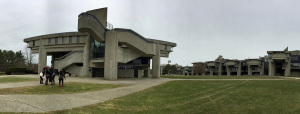 Brutalists Architects rarely got as brutal as Paul Rudolph, a man who suffered the singular misfortune of designing the Yale Art and Architecture Building. The architecture students hated the building and it even found itself a victim of a suspicious fire in 1969. Drawn from UMass Dartmouth Claire T. Carney Library archives and other sources, the exhibition “A Visionary Campus: Paul Rudolph and UMass Dartmouth” features Paul Rudolph’s architectural drawings and campus model, design materials original to Rudolph’s Group building concept, as well as interpretive responses from historians, artists, and students. Paul Rudolph was one of the leading architects in America in the 1950s and 60s. His fame spanned the time between the eras of the so-called International School and Postmodernism. His architecture was noteworthy for its unique individual style evident in all his projects. Info: UMass Dartmouth College of Visual and Performing Arts (CVPA), 285 Old Westport Road, Dartmouth, MA, Duration 16-28/4/18, Days & Hours: Mon-Sat 10:00-16:00, www.umassd.edu
Brutalists Architects rarely got as brutal as Paul Rudolph, a man who suffered the singular misfortune of designing the Yale Art and Architecture Building. The architecture students hated the building and it even found itself a victim of a suspicious fire in 1969. Drawn from UMass Dartmouth Claire T. Carney Library archives and other sources, the exhibition “A Visionary Campus: Paul Rudolph and UMass Dartmouth” features Paul Rudolph’s architectural drawings and campus model, design materials original to Rudolph’s Group building concept, as well as interpretive responses from historians, artists, and students. Paul Rudolph was one of the leading architects in America in the 1950s and 60s. His fame spanned the time between the eras of the so-called International School and Postmodernism. His architecture was noteworthy for its unique individual style evident in all his projects. Info: UMass Dartmouth College of Visual and Performing Arts (CVPA), 285 Old Westport Road, Dartmouth, MA, Duration 16-28/4/18, Days & Hours: Mon-Sat 10:00-16:00, www.umassd.edu
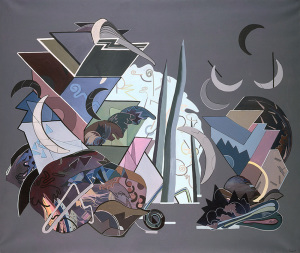 The exhibition “Post-Pop. Beyond the commonplace” present 200 works produced almost exclusively between 1965 and 1975, in Portugal and England. In the exhibition a unity can be found between the diverse works through their goodhumoured divergence from the commonplace usually proposed by Pop Art. If Pop is considered the last of the great classical languages of art, it has been followed by a period of fragmentation and dispersion of the image, at times combining abstraction and figuration. Another common link between the Portuguese artists is that they gained inspiration and incentive outside Portugal, especially in London, in reaction to the mediocrity and stagnation that existed in Portugal at the time. Despite the isolation and the repressive climate, many of the artists from the 60s generation revealed an unexpected congruity with international production. Info: Curators: Ana Vasconcelos e Patrícia Rosas, Calouste Gulbenkian Museum, Coleção do Fundador – Galeria Principal, Av. de Berna, 45A, Lisbon, Duration: 20/4-10/9/18, Days & Hours: Mon & Wed-Sun 10:00-18:00, https://gulbenkian.pt
The exhibition “Post-Pop. Beyond the commonplace” present 200 works produced almost exclusively between 1965 and 1975, in Portugal and England. In the exhibition a unity can be found between the diverse works through their goodhumoured divergence from the commonplace usually proposed by Pop Art. If Pop is considered the last of the great classical languages of art, it has been followed by a period of fragmentation and dispersion of the image, at times combining abstraction and figuration. Another common link between the Portuguese artists is that they gained inspiration and incentive outside Portugal, especially in London, in reaction to the mediocrity and stagnation that existed in Portugal at the time. Despite the isolation and the repressive climate, many of the artists from the 60s generation revealed an unexpected congruity with international production. Info: Curators: Ana Vasconcelos e Patrícia Rosas, Calouste Gulbenkian Museum, Coleção do Fundador – Galeria Principal, Av. de Berna, 45A, Lisbon, Duration: 20/4-10/9/18, Days & Hours: Mon & Wed-Sun 10:00-18:00, https://gulbenkian.pt
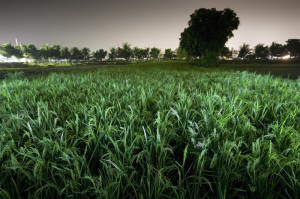 The exhibition “Global Positioning System Not Working” is on presentation at Academy of the Arts of the World in Conogne. The Global Positioning System, better known by its abbreviation GPS, was originally developed by the United States Department of Defense, but has long become an integral part of everyday life. Our positions in space are also invariably markers of our disappearance. Our positions in space are also invariably markers of our disappearance. Whether kidnapped activists in Mexico, bombing victims in Afghanistan or families devastated by right-wing terror in Germany, what remains are stories of isolation and loss, of disembodied love and memory, salvaged and also transformed in the artistic process. On presentation are works by: Shahidul Alam, Agha Shahid Ali, Ahmad Ghossein, Rafael Lozana-Hemmer, Rajkamal Kahlon, “Tribunal NSU-Komplex auflösen” and Ulf Amide / Mahnmal Keupstraße. Info: Academy of the Arts of the World, Cologne, Herwarthstraße 3, Academyspace, Cologne, Duration: 20/4-8/7/18, Days & Hours: Thu-Fri 15:00-19:00, Sat-Sun 14:00-18:00, www.academycologne.org
The exhibition “Global Positioning System Not Working” is on presentation at Academy of the Arts of the World in Conogne. The Global Positioning System, better known by its abbreviation GPS, was originally developed by the United States Department of Defense, but has long become an integral part of everyday life. Our positions in space are also invariably markers of our disappearance. Our positions in space are also invariably markers of our disappearance. Whether kidnapped activists in Mexico, bombing victims in Afghanistan or families devastated by right-wing terror in Germany, what remains are stories of isolation and loss, of disembodied love and memory, salvaged and also transformed in the artistic process. On presentation are works by: Shahidul Alam, Agha Shahid Ali, Ahmad Ghossein, Rafael Lozana-Hemmer, Rajkamal Kahlon, “Tribunal NSU-Komplex auflösen” and Ulf Amide / Mahnmal Keupstraße. Info: Academy of the Arts of the World, Cologne, Herwarthstraße 3, Academyspace, Cologne, Duration: 20/4-8/7/18, Days & Hours: Thu-Fri 15:00-19:00, Sat-Sun 14:00-18:00, www.academycologne.org
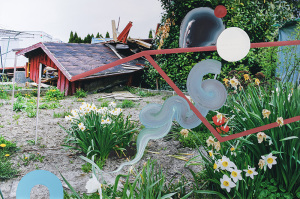 The exhibition “il giardino” by Lutz & Guggisberg is their first in an Italian museum. Stretching through five rooms, the exhibition presents more than thirty photographs of various sizes, mounted on panels and incorporating elements of painting, along with several assemblages of found objects that the artists have selected from local warehouses. These images point to the violent disruption of an established order, presenting Nature as an unconquerable force that is infinitely more powerful than human beings or human history; through a process of destruction and reconstruction, it resumes its course and reclaims control over the handiwork of man. The microcosms and macrocosms that these two artists compose and bring to life, going about the task like pseudoscientists or alchemists, draw on every branch of human knowledge: from anthropology, to literature, to the visual arts and architecture, by way of natural science. Info: Collezione Maramotti, Via Fratelli Cervi 66, Reggio Emilia, Duration: 22/4-30/12/18, Days & Hours: Thu-Fri 14:30-18:30, Sat-Sun 10:30-18:30, www.collezionemaramotti.org
The exhibition “il giardino” by Lutz & Guggisberg is their first in an Italian museum. Stretching through five rooms, the exhibition presents more than thirty photographs of various sizes, mounted on panels and incorporating elements of painting, along with several assemblages of found objects that the artists have selected from local warehouses. These images point to the violent disruption of an established order, presenting Nature as an unconquerable force that is infinitely more powerful than human beings or human history; through a process of destruction and reconstruction, it resumes its course and reclaims control over the handiwork of man. The microcosms and macrocosms that these two artists compose and bring to life, going about the task like pseudoscientists or alchemists, draw on every branch of human knowledge: from anthropology, to literature, to the visual arts and architecture, by way of natural science. Info: Collezione Maramotti, Via Fratelli Cervi 66, Reggio Emilia, Duration: 22/4-30/12/18, Days & Hours: Thu-Fri 14:30-18:30, Sat-Sun 10:30-18:30, www.collezionemaramotti.org
